

Compact Muon Solenoid
LHC, CERN
| CMS-B2G-22-005 ; CERN-EP-2024-266 | ||
| Search for pair production of heavy particles decaying to a top quark and a gluon in the lepton+jets final state in proton-proton collisions at $ \sqrt{s}= $ 13 TeV | ||
| CMS Collaboration | ||
| 27 October 2024 | ||
| EPJC 85 (2025) 342 | ||
| Abstract: A search is presented for the pair production of new heavy resonances, each decaying into a top quark (t) or antiquark and a gluon ($ \mathrm{g} $). The analysis uses data recorded with the CMS detector from proton-proton collisions at a center-of-mass energy of 13 TeV at the LHC, corresponding to an integrated luminosity of 138 fb$ ^{-1} $. Events with one muon or electron, multiple jets, and missing transverse momentum are selected. After using a deep neural network to enrich the data sample with signal-like events, distributions in the scalar sum of the transverse momenta of all reconstructed objects are analyzed in the search for a signal. No significant deviations from the standard model prediction are found. Upper limits at 95% confidence level are set on the product of cross section and branching fraction squared for the pair production of excited top quarks in the $ \mathrm{t}^{*} \to \mathrm{t}\mathrm{g} $ decay channel. The upper limits range from 0.12 pb to 0.8 fb for a $\mathrm{t}^{*}$ with spin-1/2 and from 0.015 pb to 1.0 fb for a $\mathrm{t}^{*}$ with spin-3/2. These correspond to mass exclusion limits up to 1050 and 1700 GeV for spin-1/2 and spin-3/2 $\mathrm{t}^{*}$ particles, respectively. These are the most stringent limits to date on the existence of $ \mathrm{t}^{*} \to \mathrm{t}\mathrm{g} $ resonances. | ||
| Links: e-print arXiv:2410.20601 [hep-ex] (PDF) ; CDS record ; inSPIRE record ; HepData record ; CADI line (restricted) ; | ||
| Figures | |

png pdf |
Figure 1:
Representative Feynman diagram of the signal process at leading order. |
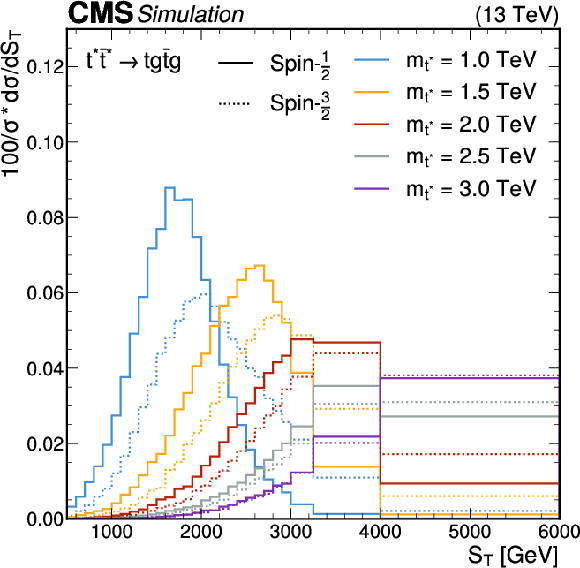
png pdf |
Figure 2:
Distributions in $ S_{\text{T}} $ for $ \mathrm{t}^{*} \overline{\mathrm{t}}{}^{*} $ signal samples with different simulated values of $ m_{\mathrm{t}^{*} } $, for spin-1/2 (solid lines) and spin-3/2 (dashed lines) resonances. The distributions were normalized to the same area for each signal. |
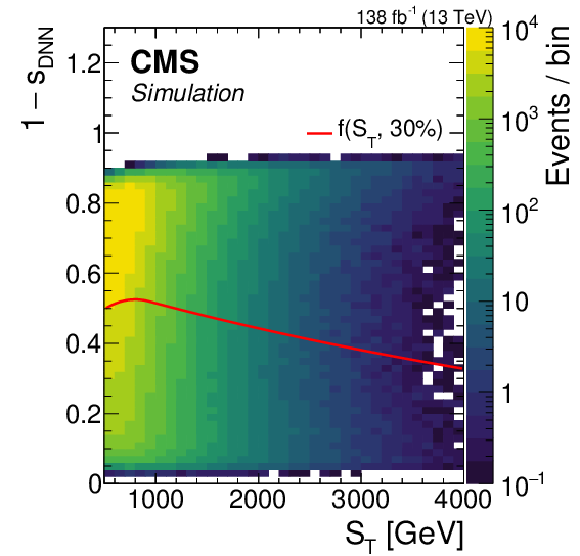
png pdf |
Figure 3:
Two-dimensional distribution in 1 $ - s_{\text{DNN}} $ versus $ S_{\text{T}} $ for simulated $ \mathrm{t} \overline{\mathrm{t}} $ events. The function $ f(S_{\text{T}}, 30%) $ (red line) is determined by specifying a 30% selection efficiency for $ \mathrm{t} \overline{\mathrm{t}} $ events, i.e.,, 30% of the $ \mathrm{t} \overline{\mathrm{t}} $ events are below this function in each bin of $ S_{\text{T}} $. |

png pdf |
Figure 4:
The simulation-based ratios between the $ S_{\text{T}} $ distributions in the SRs and CRs for the muon (left) and electron (right) channels. Two functions are fit to each ratio, and the final transfer function used for the non-t background estimation is taken to be their average. The statistical uncertainties in the transfer functions are shown as grey bands. In the lower panels, the simulation-based ratios, fit functions, and statistical uncertainties are shown relative to the final transfer function. |

png pdf |
Figure 4-a:
The simulation-based ratios between the $ S_{\text{T}} $ distributions in the SRs and CRs for the muon (left) and electron (right) channels. Two functions are fit to each ratio, and the final transfer function used for the non-t background estimation is taken to be their average. The statistical uncertainties in the transfer functions are shown as grey bands. In the lower panels, the simulation-based ratios, fit functions, and statistical uncertainties are shown relative to the final transfer function. |
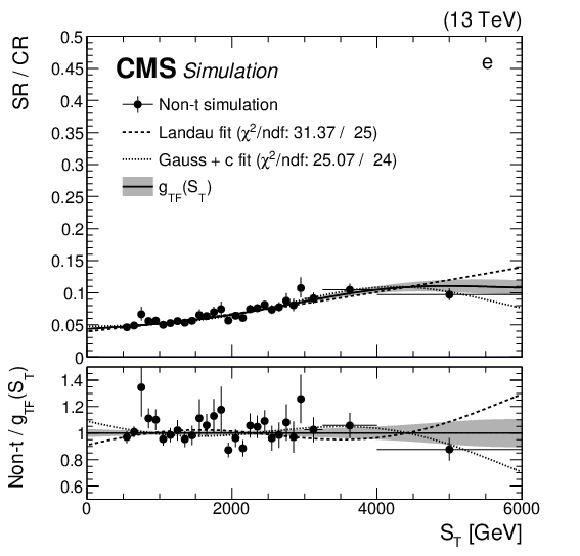
png pdf |
Figure 4-b:
The simulation-based ratios between the $ S_{\text{T}} $ distributions in the SRs and CRs for the muon (left) and electron (right) channels. Two functions are fit to each ratio, and the final transfer function used for the non-t background estimation is taken to be their average. The statistical uncertainties in the transfer functions are shown as grey bands. In the lower panels, the simulation-based ratios, fit functions, and statistical uncertainties are shown relative to the final transfer function. |

png pdf |
Figure 5:
Distributions of $ S_{\text{T}} $ in the VR for the muon (left) and electron (right) channels. The total uncertainties are shown as hatched bands. The signal distributions are scaled to the cross sections predicted by theory. Ratios of data to the expected backgrounds are shown in the lower panels. |
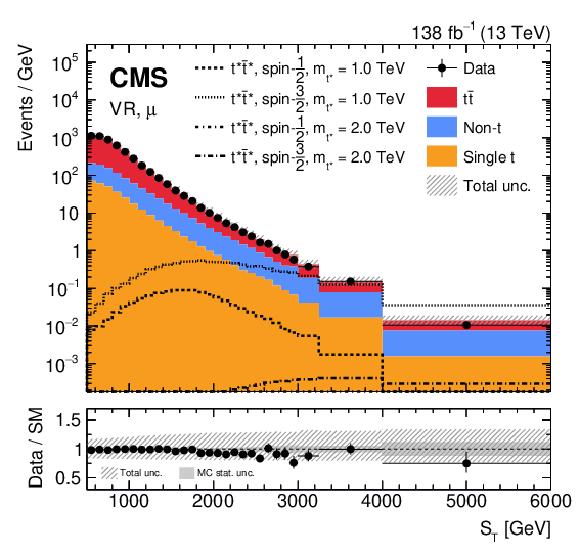
png pdf |
Figure 5-a:
Distributions of $ S_{\text{T}} $ in the VR for the muon (left) and electron (right) channels. The total uncertainties are shown as hatched bands. The signal distributions are scaled to the cross sections predicted by theory. Ratios of data to the expected backgrounds are shown in the lower panels. |

png pdf |
Figure 5-b:
Distributions of $ S_{\text{T}} $ in the VR for the muon (left) and electron (right) channels. The total uncertainties are shown as hatched bands. The signal distributions are scaled to the cross sections predicted by theory. Ratios of data to the expected backgrounds are shown in the lower panels. |

png pdf |
Figure 6:
Distributions in $ S_{\text{T}} $ in the SR for the muon (left) and electron (right) channels, after a background-only fit to the data. The signal distributions are scaled to the cross section predicted by the theory. The hatched bands show the post-fit uncertainty band, combining all sources of uncertainty. The ratio of data to the background predictions is shown in the panels below the distributions. |

png pdf |
Figure 6-a:
Distributions in $ S_{\text{T}} $ in the SR for the muon (left) and electron (right) channels, after a background-only fit to the data. The signal distributions are scaled to the cross section predicted by the theory. The hatched bands show the post-fit uncertainty band, combining all sources of uncertainty. The ratio of data to the background predictions is shown in the panels below the distributions. |

png pdf |
Figure 6-b:
Distributions in $ S_{\text{T}} $ in the SR for the muon (left) and electron (right) channels, after a background-only fit to the data. The signal distributions are scaled to the cross section predicted by the theory. The hatched bands show the post-fit uncertainty band, combining all sources of uncertainty. The ratio of data to the background predictions is shown in the panels below the distributions. |
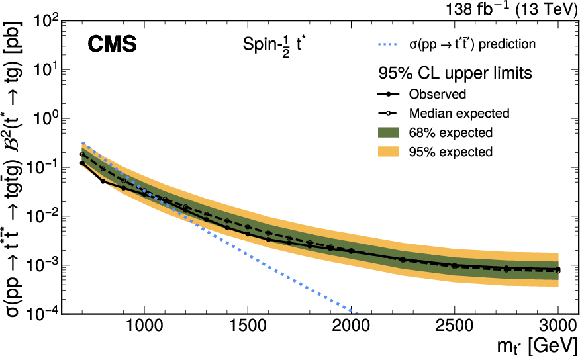
png pdf |
Figure 7:
Expected and observed 95% CL upper limits on the product of the $ \mathrm{t}^{*} \overline{\mathrm{t}}{}^{*} $ production cross section and the branching fraction squared $ \mathcal{B}^2(\mathrm{t}^{*} \to \mathrm{t}\mathrm{g}) $ for a spin-1/2 $\mathrm{t}^{*}$ as a function of $ m_{\mathrm{t}^{*} } $. The inner (green) and outer (yellow) bands give the central probability intervals containing 68 and 95% of the expected upper limits under the background-only hypothesis. The cross section predicted by theory, following the EFT approach introduced in Ref. [26], is shown as a dotted line, assuming $ \mathcal{B}(\mathrm{t}^{*} \to \mathrm{t}\mathrm{g})= $ 1. |
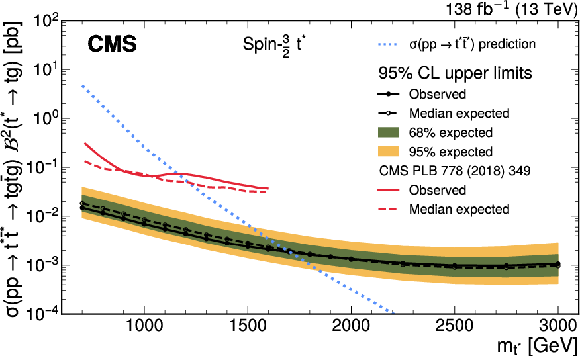
png pdf |
Figure 8:
Expected and observed 95% CL upper limits on the product of the $ \mathrm{t}^{*} \overline{\mathrm{t}}{}^{*} $ production cross section and the branching fraction squared $ \mathcal{B}^2(\mathrm{t}^{*} \to \mathrm{t}\mathrm{g}) $ for a spin-3/2 $\mathrm{t}^{*}$ as a function of $ m_{\mathrm{t}^{*} } $. The inner (green) and outer (yellow) bands give the central probability intervals containing 68 and 95% of the expected upper limits under the background-only hypothesis. The cross section predicted by theory, following the EFT approach introduced in Ref. [26], is shown as a dotted line, assuming $ \mathcal{B}(\mathrm{t}^{*} \to \mathrm{t}\mathrm{g})= $ 1. The results of the previous CMS analysis [30], using data corresponding to an integrated luminosity of 35.9 fb$ ^{-1} $, are shown as well. |
| Summary |
| A search for the pair production of heavy top-quark partners $\mathrm{t}^{*}$ has been presented, where the $\mathrm{t}^{*}$ couples predominantly to gluons and decays to a top quark and a gluon, $ \mathrm{t}^{*} \to \mathrm{t}\mathrm{g} $. Both spin-1/2 and spin-3/2 resonances are considered. The analysis uses 13 TeV proton-proton collision data collected by the CMS experiment between 2016 and 2018, corresponding to an integrated luminosity of 138 fb$ ^{-1} $. The final state analyzed consists of a lepton with high transverse momentum, missing transverse momentum and several jets. A deep neural network is used to identify potential signal events. With a two-step decorrelation procedure, independence of the deep neural network output from the main observable $ S_{\text{T}} $ has been achieved, where $ S_{\text{T}} $ is the scalar sum of the transverse momenta of the selected lepton and jets, and the missing transverse momentum. No statistically significant deviation from the background prediction was found. Upper limits at 95% confidence level are derived on the product of the $ \mathrm{t}^{*} \overline{\mathrm{t}}{}^{*} $ production cross section and branching fraction squared for $ \mathrm{t}^{*} \to \mathrm{t}\mathrm{g} $. These are between 0.12 pb and 0.8 fb for a spin-1/2 $\mathrm{t}^{*}$ and between 0.015 pb and 1.0 fb for a spin-3/2 $\mathrm{t}^{*}$, depending on the $\mathrm{t}^{*}$ mass. A comparison of these limits with the theory predictions results in mass limits for the $\mathrm{t}^{*}$ resonances, where the existence of a spin-1/2 $\mathrm{t}^{*}$ is excluded below a mass of 1050 GeV and for a spin-3/2 $\mathrm{t}^{*}$ below a mass of 1700 GeV. These are the most stringent limits to date and the first exclusion limit for a spin-1/2 $\mathrm{t}^{*}$ resonance at 13 TeV. The results also substantially improve the spin-3/2 exclusion limits compared to previous results. |
| References | ||||
| 1 | ATLAS Collaboration | Observation of a new particle in the search for the standard model Higgs boson with the ATLAS detector at the LHC | PLB 716 (2012) 1 | 1207.7214 |
| 2 | CMS Collaboration | Observation of a new boson at a mass of 125 GeV with the CMS experiment at the LHC | PLB 716 (2012) 30 | CMS-HIG-12-028 1207.7235 |
| 3 | CMS Collaboration | Observation of a new boson with mass near 125 GeV in pp collisions at $ \sqrt{s} = $ 7 and 8 TeV | JHEP 06 (2013) 081 | CMS-HIG-12-036 1303.4571 |
| 4 | H. Georgi, L. Kaplan, D. Morin, and A. Schenk | Effects of top compositeness | PRD 51 (1995) 3888 | hep-ph/9410307 |
| 5 | B. Lillie, J. Shu, and T. M. P. Tait | Top compositeness at the Tevatron and LHC | JHEP 04 (2008) 087 | 0712.3057 |
| 6 | A. Pomarol and J. Serra | Top quark compositeness: Feasibility and implications | PRD 78 (2008) 074026 | 0806.3247 |
| 7 | K. Kumar, T. M. P. Tait, and R. Vega-Morales | Manifestations of top compositeness at colliders | JHEP 05 (2009) 022 | 0901.3808 |
| 8 | T. A. DeGrand et al. | Towards partial compositeness on the lattice: Baryons with fermions in multiple representations | in Proceedings of 34th annual International Symposium on Lattice Field Theory -- PoS(LATTICE), 2016 link |
1610.06465 |
| 9 | A. Pierce and Y. Zhao | Naturalness from a composite top? | JHEP 01 (2017) 054 | 1607.01318 |
| 10 | D. Buarque Franzosi and A. Tonero | Top-quark partial compositeness beyond the effective field theory paradigm | JHEP 04 (2020) 040 | 1908.06996 |
| 11 | N. Arkani-Hamed, A. G. Cohen, E. Katz, and A. E. Nelson | The littlest Higgs | JHEP 07 (2002) 034 | hep-ph/0206021 |
| 12 | N. Arkani-Hamed, A. G. Cohen, and H. Georgi | Electroweak symmetry breaking from dimensional deconstruction | PLB 513 (2001) 232 | hep-ph/0105239 |
| 13 | M. Perelstein | Little Higgs models and their phenomenology | Prog. Part. Nucl. Phys. 58 (2007) 247 | hep-ph/0512128 |
| 14 | A. Ahmed, M. Lindner, and P. Saake | Conformal little Higgs models | PRD 109 (2024) 075041 | 2309.07845 |
| 15 | L. Randall and R. Sundrum | A large mass hierarchy from a small extra dimension | PRL 83 (1999) 3370 | hep-ph/9905221 |
| 16 | T. Gherghetta and A. Pomarol | Bulk fields and supersymmetry in a slice of AdS | NPB 586 (2000) 141 | hep-ph/0003129 |
| 17 | S. B. Giddings, S. Kachru, and J. Polchinski | Hierarchies from fluxes in string compactifications | PRD 66 (2002) 106006 | hep-th/0105097 |
| 18 | K. Agashe, R. Contino, and A. Pomarol | The minimal composite Higgs model | NPB 719 (2005) 165 | hep-ph/0412089 |
| 19 | CMS Collaboration | Search for pair production of vector-like quarks in the $ \mathrm{b}\mathrm{W}\overline{\mathrm{b}}\mathrm{W} $ channel from proton-proton collisions at $ \sqrt{s}= $ 13 TeV | PLB 779 (2018) 82 | 1710.01539 |
| 20 | CMS Collaboration | Search for electroweak production of a vector-like T quark using fully hadronic final states | JHEP 01 (2020) 036 | 1909.04721 |
| 21 | CMS Collaboration | Search for single production of a vector-like T quark decaying to a top quark and a Z boson in the final state with jets and missing transverse momentum at $ \sqrt{s} = $ 13 TeV | JHEP 05 (2022) 093 | 2201.02227 |
| 22 | CMS Collaboration | Search for pair production of vector-like quarks in leptonic final states in proton-proton collisions at $ \sqrt{s}= $ 13 TeV | JHEP 07 (2023) 020 | 2209.07327 |
| 23 | ATLAS Collaboration | Search for pair-produced vector-like top and bottom partners in events with large missing transverse momentum in pp collisions with the ATLAS detector | EPJC 83 (2023) 719 | 2212.05263 |
| 24 | ATLAS Collaboration | Search for pair-production of vector-like quarks in pp collision events at $ \sqrt{s}= $ 13 TeV with at least one leptonically decaying Z boson and a third-generation quark with the ATLAS detector | PLB 843 (2023) 138019 | 2210.15413 |
| 25 | ATLAS Collaboration | Search for singly produced vector-like top partners in multilepton final states with 139 fb$^{-1} $ of pp collision data at $ \sqrt{s} = $ 13 TeV with the ATLAS detector | PRD 109 (2024) 112012 | 2307.07584 |
| 26 | H. Alhazmi, J. H. Kim, K. Kong, and I. M. Lewis | Shedding light on top partner at the LHC | JHEP 01 (2019) 139 | 1808.03649 |
| 27 | J. Berger, J. Hubisz, and M. Perelstein | A fermionic top partner: Naturalness and the LHC | JHEP 07 (2012) 016 | 1205.0013 |
| 28 | W. Rarita and J. Schwinger | On a theory of particles with half integral spin | PR 60 (1941) 61 | |
| 29 | CMS Collaboration | Search for pair production of excited top quarks in the lepton+jets final state | JHEP 06 (2014) 125 | 1311.5357 |
| 30 | CMS Collaboration | Search for pair production of excited top quarks in the lepton+jets final state | PLB 778 (2018) 349 | 1711.10949 |
| 31 | CMS Collaboration | HEPData record for this analysis | link | |
| 32 | CMS Collaboration | The CMS experiment at the CERN LHC | JINST 3 (2008) S08004 | |
| 33 | CMS Collaboration | Development of the CMS detector for the CERN LHC Run 3 | JINST 19 (2024) P05064 | CMS-PRF-21-001 2309.05466 |
| 34 | CMS Collaboration | Performance of the CMS level-1 trigger in proton-proton collisions at $ \sqrt{s}= $ 13 TeV | JINST 15 (2020) P10017 | CMS-TRG-17-001 2006.10165 |
| 35 | CMS Collaboration | The CMS trigger system | JINST 12 (2017) P01020 | CMS-TRG-12-001 1609.02366 |
| 36 | J. Alwall et al. | The automated computation of tree-level and next-to-leading order differential cross sections, and their matching to parton shower simulations | JHEP 07 (2014) 079 | 1405.0301 |
| 37 | D. A. Dicus, D. Karabacak, S. Nandi, and S. K. Rai | Search for spin-3/2 quarks at the Large Hadron Collider | PRD 87 (2013) 015023 | 1208.5811 |
| 38 | P. Nason | A new method for combining NLO QCD with shower Monte Carlo algorithms | JHEP 11 (2004) 040 | hep-ph/0409146 |
| 39 | S. Frixione, P. Nason, and C. Oleari | Matching NLO QCD computations with parton shower simulations: The POWHEG method | JHEP 11 (2007) 070 | 0709.2092 |
| 40 | S. Frixione, P. Nason, and G. Ridolfi | A positive-weight next-to-leading-order Monte Carlo for heavy flavour hadroproduction | JHEP 09 (2007) 126 | 0707.3088 |
| 41 | S. Alioli, P. Nason, C. Oleari, and E. Re | A general framework for implementing NLO calculations in shower Monte Carlo programs: The POWHEG BOX | JHEP 06 (2010) 043 | 1002.2581 |
| 42 | E. Re | Single-top $ {\mathrm{W}}{\mathrm{t}} $-channel production matched with parton showers using the POWHEG method | EPJC 71 (2011) 1547 | 1009.2450 |
| 43 | M. Czakon and A. Mitov | Top++: A program for the calculation of the top-pair cross-section at hadron colliders | Comput. Phys. Commun. 185 (2014) 2930 | 1112.5675 |
| 44 | T. Sjöstrand et al. | An introduction to PYTHIA 8.2 | Comput. Phys. Commun. 191 (2015) 159 | 1410.3012 |
| 45 | NNPDF Collaboration | Parton distributions from high-precision collider data | EPJC 77 (2017) 663 | 1706.00428 |
| 46 | CMS Collaboration | Event generator tunes obtained from underlying event and multiparton scattering measurements | EPJC 76 (2016) 155 | CMS-GEN-14-001 1512.00815 |
| 47 | GEANT4 Collaboration | GEANT 4---a simulation toolkit | NIM A 506 (2003) 250 | |
| 48 | CMS Collaboration | Measurement of the inelastic proton-proton cross section at $ \sqrt{s}= $ 13 TeV | JHEP 07 (2018) 161 | CMS-FSQ-15-005 1802.02613 |
| 49 | CMS Collaboration | Particle-flow reconstruction and global event description with the CMS detector | JINST 12 (2017) P10003 | CMS-PRF-14-001 1706.04965 |
| 50 | CMS Collaboration | Performance of the CMS muon detector and muon reconstruction with proton-proton collisions at $ \sqrt{s}= $ 13 TeV | JINST 13 (2018) P06015 | CMS-MUO-16-001 1804.04528 |
| 51 | CMS Collaboration | Performance of CMS muon reconstruction in pp collision events at $ \sqrt{s}= $ 7 TeV | JINST 7 (2012) P10002 | CMS-MUO-10-004 1206.4071 |
| 52 | CMS Collaboration | Performance of the reconstruction and identification of high-momentum muons in proton-proton collisions at $ \sqrt{s}= $ 13 TeV | JINST 15 (2020) P02027 | CMS-MUO-17-001 1912.03516 |
| 53 | CMS Collaboration | Electron and photon reconstruction and identification with the CMS experiment at the CERN LHC | JINST 16 (2021) P05014 | CMS-EGM-17-001 2012.06888 |
| 54 | CMS Collaboration | ECAL 2016 refined calibration and Run2 summary plots | CMS Detector Performance Summary CMS-DP-2020-021, 2020 CDS |
|
| 55 | M. Cacciari, G. P. Salam, and G. Soyez | The anti-$ k_{\mathrm{T}} $ jet clustering algorithm | JHEP 04 (2008) 063 | 0802.1189 |
| 56 | M. Cacciari, G. P. Salam, and G. Soyez | FastJet user manual | EPJC 72 (2012) 1896 | 1111.6097 |
| 57 | D. Bertolini, P. Harris, M. Low, and N. Tran | Pileup per particle identification | JHEP 10 (2014) 059 | 1407.6013 |
| 58 | CMS Collaboration | Pileup mitigation at CMS in 13 TeV data | JINST 15 (2020) P09018 | CMS-JME-18-001 2003.00503 |
| 59 | CMS Collaboration | Jet energy scale and resolution in the CMS experiment in pp collisions at 8 TeV | JINST 12 (2017) P02014 | CMS-JME-13-004 1607.03663 |
| 60 | T. Lapsien, R. Kogler, and J. Haller | A new tagger for hadronically decaying heavy particles at the LHC | EPJC 76 (2016) 600 | 1606.04961 |
| 61 | M. Cacciari, G. P. Salam, and G. Soyez | The catchment area of jets | JHEP 04 (2008) 005 | 0802.1188 |
| 62 | CMS Collaboration | Identification of heavy, energetic, hadronically decaying particles using machine-learning techniques | JINST 15 (2020) P06005 | CMS-JME-18-002 2004.08262 |
| 63 | R. Kogler | Advances in jet substructure at the LHC: Algorithms, measurements and searches for new physical phenomena | Volume 284 of Springer Tracts Mod. Phys. Springer, ISBN~978-3-030-72857-1, 978-3-030-72858-8, 2021 link |
|
| 64 | J. Thaler and K. Van Tilburg | Identifying boosted objects with $ N $-subjettiness | JHEP 03 (2011) 015 | 1011.2268 |
| 65 | J. Thaler and K. Van Tilburg | Maximizing boosted top identification by minimizing $ N $-subjettiness | JHEP 02 (2012) 093 | 1108.2701 |
| 66 | CMS Collaboration | Search for a heavy resonance decaying into a top quark and a W boson in the lepton+jets final state at $ \sqrt{s} = $ 13 TeV | JHEP 04 (2022) 048 | 2111.10216 |
| 67 | CMS Collaboration | Identification of heavy-flavour jets with the CMS detector in pp collisions at 13 TeV | JINST 13 (2018) P05011 | CMS-BTV-16-002 1712.07158 |
| 68 | E. Bols et al. | Jet flavour classification using DeepJet | JINST 15 (2020) P12012 | 2008.10519 |
| 69 | CMS Collaboration | Performance summary of AK4 jet b tagging with data from proton-proton collisions at 13 TeV with the CMS detector | Technical Report CMS-DP-2023-005, 2023 CDS |
|
| 70 | CMS Collaboration | Performance of missing transverse momentum reconstruction in proton-proton collisions at $ \sqrt{s} = $ 13\,TeV using the CMS detector | JINST 14 (2019) P07004 | CMS-JME-17-001 1903.06078 |
| 71 | CMS Collaboration | Search for resonant $ \mathrm{t}\overline{\mathrm{t}} $ production in proton-proton collisions at $ \sqrt{s}= $ 13 TeV | JHEP 04 (2019) 031 | 1810.05905 |
| 72 | J. Dolen et al. | Thinking outside the ROCs: Designing decorrelated taggers (DDT) for jet substructure | JHEP 05 (2016) 156 | 1603.00027 |
| 73 | CMS Collaboration | Measurement of the differential cross section for top quark pair production in pp collisions at $ \sqrt{s}= $ 8 TeV | EPJC 75 (2015) 542 | CMS-TOP-12-028 1505.04480 |
| 74 | CMS Collaboration | Measurement of the $ {\mathrm{t}\overline{\mathrm{t}}} $ production cross section in the all-jets final state in pp collisions at $ \sqrt{s}= $ 8 TeV | EPJC 76 (2016) 128 | CMS-TOP-14-018 1509.06076 |
| 75 | CMS Collaboration | The CMS statistical analysis and combination tool: COMBINE | Accepted by Comput. Softw. Big Sci, 2024 | CMS-CAT-23-001 2404.06614 |
| 76 | CMS Collaboration | Precision luminosity measurement in proton-proton collisions at $ \sqrt{s} = $ 13 TeV in 2015 and 2016 at CMS | EPJC 81 (2021) 800 | CMS-LUM-17-003 2104.01927 |
| 77 | CMS Collaboration | CMS luminosity measurement for the 2017 data-taking period at $ \sqrt{s} = $ 13 TeV | CMS Physics Analysis Summary, 2018 link |
CMS-PAS-LUM-17-004 |
| 78 | CMS Collaboration | CMS luminosity measurement for the 2018 data-taking period at $ \sqrt{s} = $ 13 TeV | CMS Physics Analysis Summary, 2019 link |
CMS-PAS-LUM-18-002 |
| 79 | J. Butterworth et al. | PDF4LHC recommendations for LHC Run II | JPG 43 (2016) 023001 | 1510.03865 |
| 80 | ATLAS and CMS Collaborations, and LHC Higgs Combination Group | Procedure for the LHC Higgs boson search combination in Summer 2011 | CMS Note CMS-NOTE-2011-005, ATL-PHYS-PUB-2011-11, 2011 | |
| 81 | A. L. Read | Presentation of search results: The CL$ _{\text{s}} $ technique | JPG 28 (2002) 2693 | |
| 82 | T. Junk | Confidence level computation for combining searches with small statistics | NIM A 434 (1999) 435 | hep-ex/9902006 |
| 83 | G. Cowan, K. Cranmer, E. Gross, and O. Vitells | Asymptotic formulae for likelihood-based tests of new physics | EPJC 71 (2011) 1554 | 1007.1727 |
| 84 | W. Verkerke and D. P. Kirkby | The RooFit toolkit for data modeling | in Proc. Int. Conf on Computing in High Energy and Nuclear Physics (CHEP03), L. Lyons and M. Karagoz, eds., 2003 link |
physics/0306116 |
| 85 | L. Moneta et al. | The RooStats project | in Proc. 13th Int. Workshop on Advanced Computing and Analysis Techniques in Physics Research, T. Speer et al., eds., 2010 link |
1009.1003 |

|
Compact Muon Solenoid LHC, CERN |

|

|

|

|

|

|